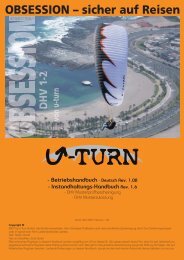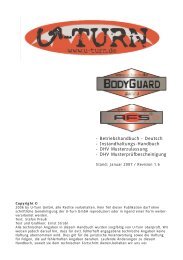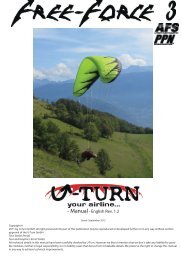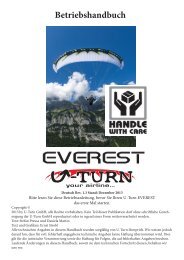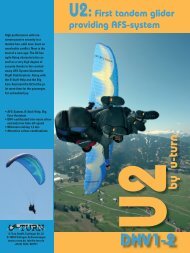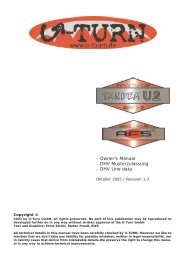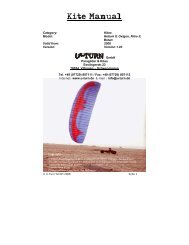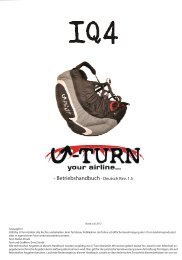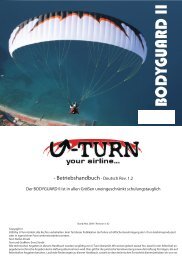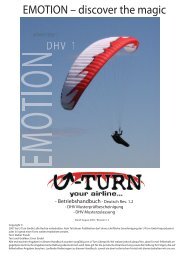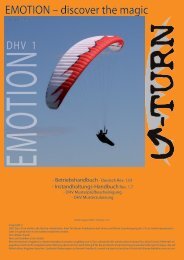ALPINE PEAK - U-Turn Paragliders
ALPINE PEAK - U-Turn Paragliders
ALPINE PEAK - U-Turn Paragliders
You also want an ePaper? Increase the reach of your titles
YUMPU automatically turns print PDFs into web optimized ePapers that Google loves.
Business Reply CardU-TURN GmbHEsslinger Straße 23D-78054 Villingen-SchwenningenNAME:.................................................................................................................FIRST NAME:........................................................................................................STREET:...............................................................................................................ZIP CODE / CITY:...................................................................................................TELEPHONE:........................................................................................................E-MAIL:............................................................................................................................................................................................................................................PARAGLIDER TYPE:.............................................................................................SERIAL NUMBER:..................................................................................................Date of purchase:................................................................................................Dealership:......................................................................................................................................................................................................................................Tested by:...........................................................................................................Flying hours.:........................................................................................................Paraglider since:...................................................................................................Miscellaneous:.........................................................................................................................................................................................................................................................................................................................................................................................................................................................................................Yes, I would like to get the newsletter by email.
ContentsIntroduction..............................................................................................................General Description - <strong>ALPINE</strong> <strong>PEAK</strong>Page 1Page 1AFS- System..................................................................................................... Page 2Mylar Fix System Page 3New Features / Important- please read this..................................................... Page 4Material List Page 4Take off weight / Table of surface load............................................................ Page 4Technical Data Page 5Technical Data - Material Mix................................................................. Page 6Order form for lines / Instruction leaflet for repairs Page 7General layout drawing line system, line ID...................................................... Page 8Lines allocation plan / Liros lines Data - Line plan XS, S, M, L Page 9-13Lines and risers................................................................................................. Page 14Riser, Speed Systems, Suitable Harness Page 14Risers........................................................................................................ Page 15Suitable Rescue System Page 16Operation................................................................................................................ Page 16Field of Operation Page 16Aerobatics........................................................................................................ Page 16Motorised Paragliding Page 16Preflight Check.................................................................................................. Page 16Take off Page 17<strong>Turn</strong>ing............................................................................................................... Page 17Active Flying Page 17Landing.............................................................................................................. Page 18Winching Page 18Advance Handling................................................................................................ Page 18Wingover Page 19Frontstall........................................................................................................... Page 19Stall Page 19Fullstall.............................................................................................................. Page 19Emergency Piloting Page 19Negative <strong>Turn</strong>................................................................................................... Page 19Collapses Page 20How to avoid collapses - by Ernst Strobl........................................................... Page 20Rapid Descent Page 21Spiral Dive................................................................................................ Page 21“Big Ears” Page 21B-Stall....................................................................................................... Page 21
ContentsMaintenance and Repairs......................................................................................... Page 22Safety advice and liability Page 23Nature and environment friendly behaviour............................................................... Page 23Removal Page 23Example CertificationDHV - Example Certification<strong>ALPINE</strong> <strong>PEAK</strong> XS Page 24<strong>ALPINE</strong> <strong>PEAK</strong> SPage 25<strong>ALPINE</strong> <strong>PEAK</strong> MPage 26<strong>ALPINE</strong> <strong>PEAK</strong> LPage 27
Introduction<strong>Paragliders</strong> made by U-<strong>Turn</strong> are a class its own. U-<strong>Turn</strong> stands for uncompromising safety, best componentsand outperforming flight-characteristics. Fly it and be happy, as U-<strong>Turn</strong> is the brand for those whoappreciate the difference. The limits of physics are unbribable. To do the most practicable within thisgiven frame is our goal. We concede: This is an ambitious and somehow immodest demand, but you`llfind U-<strong>Turn</strong> always at the cutting edge of technology. Oscar Wild once said in his very britishunderstatment his taste is just basic: Only the best is always good enough. The U-<strong>Turn</strong> team agreeswith this attitude: We always want to deliver the best possible glider. Not more, but certainly not less.Customer`s wishes are key for the U-<strong>Turn</strong> staff, so we appreciate any comments. Please feel free tocontact your competence center of U-<strong>Turn</strong> directly when you`re in need for a good piece of advice.General Description <strong>ALPINE</strong> <strong>PEAK</strong>That beats everythingIf the <strong>ALPINE</strong> <strong>PEAK</strong> were a top model, it would no longer be allowed on the catwalk, as the very thinones are no longer welcome there. But sometimes less is more like with the <strong>ALPINE</strong> <strong>PEAK</strong>. The newlightweight by U-<strong>Turn</strong> with DHV-1 classification has not an ounce too much on the V-ribs. The glider in theXS-version weighs a full 3,9 kilograms, and that’s at ideal proportions.The latest development of Ernst Strobl, head of U-<strong>Turn</strong> design, refers specifically to mountain climbersand other close-to-nature pilots, who like to drag their glider up the mountain, before they take off. Allother pilots can take advantage of the lightweight construction as well, of course. First and foremost theabsolutely uncomplicated take off attitude deserves mentioning: the <strong>ALPINE</strong> <strong>PEAK</strong> doesn’t even knowshooting forward through hearsay, the easy filling is remarkably even and the take off remarkablyuncomplicated.In the air the <strong>ALPINE</strong> <strong>PEAK</strong> convinces through high passive security because the lighter materials approachthe system of the AFS a smidgen more delicately. Also the efficiency is improved compared to the EMO-TION, which it derived from. The <strong>ALPINE</strong> <strong>PEAK</strong> is a touch faster and a little more direct and ascends a bitbetter in the thermal- which is not a surprise as the low masses achieve appropriate impact.The new glider sets on Skytex 36 (40%) in the upper sail, the rest is made up of Skytex 27. Except forthe slim design stripe, which is made of the 36 material, the Skytex 27 is exclusively applied in the lowersail. Also the V-ribs (except of the line sets) and the V-tapes are manufactured of the 27 cloth. The riseris made of 12 millimetres Kevlar and the Liros lines represent an optimal mix of weight reduction andstability.“We waited to introduce this extremely light glider to the market until we were absolutely convinced ofthe consistency and the capacity of the available material”, both design engineer Ernst Strobl and managerThomas Vosseler explain. The UV-resistance of the material and the abidance of the acerb U-<strong>Turn</strong>quality norm, which concern the permanent porosity of the material, were tested over a long period andwith countless test flights.Page 1
Automatic flight stabilisationWith the AFS U-<strong>Turn</strong> offers a unique security feature to their customers.To fly safely means to fly actively - the system employed on the <strong>ALPINE</strong> <strong>PEAK</strong> allows this to happen automaticallyto a certain level. The secret of the AFS-system is based on a pre-tensioning principle. In thearea of the brake attachment points the undersurface is pre-tensioned. Whilst the sail is gliding throughsmooth air, there is enough pressure inside and the pre-tensioning is neutralised: The effect of internalpressure is more powerful than the pre-tensioning and the trailing edge stays aerodynamically perfectin the air like a conventional glider. When entering turbulent air with the <strong>ALPINE</strong> <strong>PEAK</strong> the system adjustsimmediately, even the slightest drop of internal pressure allows the system to react. The pre-tensioningat the trailing edge is effectively like pulling the brakes.Ernst Strobl recalls the fine-tuning, „Our computer-based calculations were impressively confirmed duringour tests“. The system is extremely responsive so that a top-quality manufacturing is key. U-<strong>Turn</strong>Cofounder Thomas Vosseler adds, „We guarantee a strongly supervised manufacturing process“.The AFS works like the Electronic Stability Programs known in the automotive industry, you could call it an„ESP for the air“. It intervenes for the benefit of safety when an inexperienced pilot, or a pilot in trouble,enters turbulence and is unable to fly actively.Experienced flight-instructors confirm, „This is a major step as far as safety is concerned. The main reasonfor accidents, the full collapse of the canopy, is minimized dramatically“.Even without AFS the <strong>ALPINE</strong> <strong>PEAK</strong> would be a very safe glider says Strobl. Due to the extremely pulleddown winglets and the resulting spread of the canopy the <strong>ALPINE</strong> <strong>PEAK</strong> has far more than averageresistance to collapses. The <strong>ALPINE</strong> <strong>PEAK</strong> glides stably ahead even after an accelerated asymmetriccollapse, a situation that may happen after leaving a thermal, even with 50% of the wing area collapsed.This is simply outstanding. The computer optimised wing layout leads to very good thermal liftand maximizes the stall characteristics, both improving safety.Page 2Page 2
Mylar Fix SystemU-<strong>Turn</strong> stands for innovative ideas and with the Mylar Fix System the company has once again provenitself as a trendsetter. The system allows the pilot to pack the paraglider, even during light wind conditionsalone and without help at the packing area, in such a way as to ensure that the profile front sideMylar-reinforcements do not get creased. This caring method leads to a significantly longer lifetime ofthe paraglider and better performance simultaneously. Serious creasing of the leading profile can beavoided for years when carried out correctly and with sufficient care during the folding operation.This is very important because creased reinforcements even for short time area strain reliefs in flight tendto return to the creased condition. The result: The paraglider will not be correctly in the air stream andloses performance and ultimately will be more susceptible for unwanted flying situations. This behaviouris similar during the start phase. The less the reinforcements are creased the easier it is to raise and startthe Alpine Peak AFS. A small detail which however can hardly be overestimated in its use and impactand contributes significantly to uphold the value and high performance of the Alpine Peak.On the right and left(from the middle of theglider) Mylar reinforcementare reinforcingvelcro. 1) Take thisout of the velcro anchorange…and thread throughthe slots in Mylarreinforcements 2 and3 etc..Press each reinforcementneatly onto thenext. That will make fora strong packing that isprotected frombending.Once all reinforcementsare precisely beadedand gathered up youcan attach the velcro toits counterpart and theneatly stacked Mylarreinforcement will stayin shape.Ensure that the velcrosits tight – and theprofile edge stays inshape.That’s what thefinished glider lookslike. Now the back partcan be folded rail byrail and rolled up.Page 3
New FeaturesAlong with these safety features the U-<strong>Turn</strong> <strong>ALPINE</strong> <strong>PEAK</strong> also offers comfort features to enhance thefun of the sport. With the Easy Fix, the riser of the gliders are being fixed after the glider is folded.The Dirt-Outs on the flying terrain, make the removal of dirt and foliage in the canopy easier.In fact the U-<strong>Turn</strong> <strong>ALPINE</strong> <strong>PEAK</strong> does not only set new safety standards, it also changes the way paraglidersare constructed. Although the entire developmental process was dictated by safety, ErnstStrobl managed to create a piece of equipment that is guaranteed fun. With that in mind, the U-<strong>Turn</strong><strong>ALPINE</strong> <strong>PEAK</strong> is, without compromise, made to be safe, without compromising the joy of paragliding.Important:Having the necessary level of experience never substitutes the need to familiarize yourself with theglider before leaving the ground. Please carefully read the handbook and take advantage of the supportyour flight school, as well as U-<strong>Turn</strong>, offer.Please always remember that aviation can potentially be dangerous and your safety lies in your ownhands. We strongly encourage you to fly conservatively; this includes the choices you make concerningflight conditions as well as the choices you make during flight.General Description - Material listMarking of componentsMaterial / product nametechnical data / Dimensionweight / strengthProducerAttachement loops Nylon 7,2 g/m / Breaking load 110 kg / 13 mm spreads Kolon Industrial Co, KoreaAccelerator lines Nylon Ø 4,0 mm = Breaking load 350 daNAccelerator - brakeroll GIN Rolle Gin Glider KoreaAccelerator lock Brummelhook Gin Glider Koreabrake attachements Nylon 7,2g/m Breaking load 110 kg / 13mm spreads Kolon Industrial Co, Koreabrake handhold High Tanacity Poliester Yam 22mm 25 g/m / 1000 kg Breaking load Techni Sangles, Francebrake handhold attachement High Tanacity Poliester Yam 22mm 25 g/m / 1000 kg Breaking load Techni Sangles, Francebrake handhold fixation Magnet Gin Glider Koreabreak main line 2,3 mm Ø Dynema Lines 2,3 mm = 250 daN Gin Teijin KoreaLines DC60, DSL 70,PSSL 120, 160, 200, 275Liros LinesRosenberger TauwerkeGin Gliders Koreabelt redirection Stainless Steel 8g/Ø 3,8 mm / Breaking load 800kg Ansung Precision CO. Korealines lock Stainless Steel 12g / Ø 4,3 mm / Breaking load 1000kg Ansung Precision CO. KoreaTop sail Skytex 36 / Skytex 27 36 g/m² / 27g/m² (PA 6,6 HT) Porcher Marine, NCV, FranceV-Tape Skytex 27 27 g/m² (PA 6,6 HAT) Paratex, GermanyNose reinforcement P 260 283 g/m² Dimension-Polyant, GermanyRips, Profile Skytex 36 / Skytex 27 36 g/m² / 27g/m² (PA 6,6 HT) Paratex, KoreaRiser High Tanacity Poliester Yam 22mm 25 g/m / 1000 kg Breaking load Techni Sangles, FranceUndersail Skytex 27 27 g/m² (PA 6,6 HT) Porcher Marine, NCV, FranceReinforcement pivot point B/C/D W 420 180 g/m² Porcher Marine, NCV, Francesewing thread conopy High Tanacity Poliester Yam 150 D/2 0,05 g/m² / 2,9 kg Breaking load Amann & Söhne GmbH, Germanysewing thread lines High Tanacity Poliester Yam 150 D/3 0,083 g/m² / 3,2 kg Breaking load Amann & Söhne GmbH, GermanyTable of surface loadinggpStart Weight (kg) 55 60 65 70 75 80 85 90 95 100 105 110 115 120 125 130Alpine Peak L 3,3 3,4 3,6 3,8 3,9 4,1 4,3Alpine Peak M 3,0 3,2 3,3 3,5 3,7 3,9Alpine Peak S 2,7 2,9 3,1 3,3 3,5 3,7Alpine Peak XS 2,3 2,5 2,7 2,9 3,1 3,3Page 4
Technical Data U-<strong>Turn</strong> <strong>ALPINE</strong> <strong>PEAK</strong> XS, S, M, LXS S M LAlpine PeakTake off weight 55 - 80 kg 70 - 90 kg 85 - 110 kg 100 - 130 kgWing area flat 24 m² 26 m² 28,5 m² 31,0 m²Wing area project 21,85 m² 23,63 m² 25,63 m² 27,65 m²Wing span flat 11,0 m 11,44 m 11,91 m 12,38 mWing span project 9,3 m 9,67 m 10,07 m 10,46 mAspect ratio flat 4,94 4,94 4,94 4,94Aspect ratio flat project 3,95 3,95 3,95 3,95Number of chambers 41 41 41 41V-Trimm ~38-39 Km/h ~38-39 Km/h ~38-39 Km/h ~38-39 Km/hV-Min ~ 22 Km/h ~ 22 Km/h ~ 21 Km/h ~ 20 Km/hV-Max ~ 48 Km/h ~ 48 Km/h ~ 48 Km/h ~ 48 Km/hAFS, BFS**,Dirt Out,AFS, BFS**,Dirt Out,AFS, BFS**,Dirt Out,Features AFS, BFS**,Dirt Out,Page 5Tension Stripes Tension Stripes Tension Stripes Tension StripesNumber of risers 5 5 5 5Number of lines storeys 3 3 3 3Accelerator / Trimmer Accelerator Accelerator Accelerator AcceleratorGlider weight 3,8 kg 4,0 kg 4,2 kg 4,4 kgCertification DHV DHV 1 DHV 1 DHV 1 DHV 1You will find further details regarding the construction and measurement of the U-<strong>Turn</strong> OBSESSION 2 in the “Typenkennblatt” or, in case of equipmentwith example registration, in the “Luftsportgerätekennblatt” in accordance with paragraph four of the “Luftverkehrszulassung”. (See attachments)You can find possible technical changes in the attachment to this manual.Warning: any self inflicted changes to the construction that go beyond the allowed adjustment options, void the operating license andare potentially life threatening. Use of this paraglider is at your own risk. The producer and distributor cannot be held liable.
Technical Data - Material Mixc21r20c20r19c19r18on pag 4, material list, you can find informationon which NCV Material Nylon is used andwhere.<strong>ALPINE</strong> <strong>PEAK</strong> rev 0r17r16r15r14r13r12Ribs 18, 15, 12, 9, 8, 7, 6, 5, 4, 3, 2, 1: Skytex 27Ribs 20, 19, 17, 16, 14, 13, 11, 10: Skytex 36V-Tapes: Skytex 27r11r10r9r8r7r6r5r4r3r2r1c1c2c3c4c6c5c8c7c10 c9c12 c11c14 c13c18 c17 c16 c15Page 6
Order form for lines and instruction leaflet for repairsU-<strong>Turn</strong> GmbH Tel: +49 (0)7720/807111Esslingerstr. 23 Fax: +49 (0)7720/80711278054 Villingen-SchwenningenGermanyLINE ORDER SHEET / BESTELLFORMULAR FÜR LEINENNameAdress / AdresseE-mailTelephone Number /Telefon NummerParagliding name /Gleitschirm NameSize / GrößeOther / SonstigesSerial Number / Serien Nummer: _ _ _ _ ____ _ _ - _ _ _ _ - _ _ _ _Line ID /BezeichnungQuantity/StückzahlLine ID /BezeichnungQuantity/StückzahlInstruction leaflet for repairs and 2 annual CheckName:Adress:Land:E-Mail:Paraglider type:Telephone Number:Serial number:comments/notes:2 annual Check Line Check incl. strength testAir permeability checkRepair of the marked damageRecall with sighting of the paragliderPlease, pretend the repair-destitute place in the upper sail and / or under sail.Page 7
General layout drawing 2D / lineplanBrM2r7AT7AM2BT7AM2CT7AM2DT7AM2BrMainr6r5AT5AM1BT5AM1CT5AM1DT5AM1BrT6BrM1Stabir4AT4r3BT4Alpine PeakLine CodeAT2BT2CT4CT2DT4DT2BrT4 BrT3r2r1ST1ST2ST3r20 r19 r18 r17 r16 r15r14r13r12AT20AT19AT17r11AT16AT14r10AT13AM6r9AM5AT11r8A3A2AM4AT10AM3AT8BT20BT19 BT17BT16 BT14BT13AM6A1AM5BT11BT10AM4B3AM3BT8B2B1CT20CT19 CT17CT16CT14CT13CT11CT10AM6 AM5CT8AM4 AM3C3C2C1ST4Page 8DT20DT19 DT17DT16 DT14DT13 DT11DT10 DT8AM6 AM5AM4 AM3D1D3 D2BrT10 BrT8BrT18BrT14BrT20BrT16BrT12BrL1BrM4 BrM3BrL2
Lines allocation plan / Liros lines dataAlpine Peak03.02.2008 Alpine PeaklineconfigA-LinesA-Linesr 20 AT20 AM6 A 3 r 20 DC 60 PPSL 120 PPSL 275r 19 AT19 r 19 DC 60r 17 AT17 AM5 r 17 DC 60 PPSL 120r 16 AT16 r 16 DC 60r 14 AT14 AM4 A 2 r 14 DC 60 PPSL 120 PPSL 200r 13 AT13 r 13 DC 60r 11 AT11 AM3 r 11 DC 60 PPSL 120r 10 AT10 r 10 DC 60r 8 AT8 AM2 A 1 r 8 DC 60 DSL 70 PPSL 160r 7 AT7 r 7 DC 60r 5 AT5 AM1 r 5 DC 60 DSL 70r 4 AT4 r 4 DC 60r 2 AT2 r 2 DC 60Stabilo ST1 Stabilo DC 60B-Lines !Riser lenght is 700mm!B-Linesr 20 BT20 BM6 B 3 r 20 DC 60 PPSL 120 PPSL 275r 19 BT19 r 19 DC 60r 17 BT17 BM5 r 17 DC 60 PPSL 120r 16 BT16 r 16 DC 60r 14 BT14 BM4 B 2 r 14 DC 60 PPSL 120 PPSL 200r 13 BT13 r 13 DC 60r 11 BT11 BM3 r 11 DC 60 PPSL 120r 10 BT10 r 10 DC 60r 8 BT8 BM2 B 1 r 8 DC 60 DSL 70 PPSL 160r 7 BT7 r 7 DC 60r 5 BT5 BM1 r 5 DC 60 DSL 70r 4 BT4 r 4 DC 60r 2 BT2 r 2 DC 60Stabilo ST1 ST1 Stabilo DC 60 PPSL 120C-LinesC-Linesr 20 CT20 CM6 C 3 r 20 DC 60 PPSL 120 PPSL 200r 19 CT19 r 19 DC 60r 17 CT17 CM5 r 17 DC 60 PPSL 120r 16 CT16 r 16 DC 60r 14 CT14 CM4 C 2 r 14 DC 60 DSL 70 PPSL 160r 13 CT13 r 13 DC 60r 11 CT11 CM3 r 11 DC 60 DSL 70r 10 CT10 r 10 DC 60r 8 CT8 CM2 C 1 r 8 DC 60 DSL 70 PPSL 120r 7 CT7 r 7 DC 60r 5 CT5 CM1 r 5 DC 60 DSL 70r 4 CT4 r 4 DC 60r 2 CT2 r 2 DC 60Stabilo ST1 Stabilo DC 60D-LinesD-Linesr 20 DT20 DM6 D 3 r 20 DC 60 DSL 70 PPSL 160r 19 DT19 r 19 DC 60r 17 DT17 DM5 r 17 DC 60 DSL 70r 16 DT16 r 16 DC 60r 14 DT14 DM4 D 2 r 14 DC 60 DSL 70 PPSL 120r 13 DT13 r 13 DC 60r 11 DT11 DM3 r 11 DC 60 DSL 70r 10 DT10 r 10 DC 60r 8 DT8 DM2 D 1 r 8 DC 60 DC 60 DSL 70r 7 DT7 r 7 DC 60r 5 DT5 DM1 r 5 DC 60 DC 60r 4 DT4 r 4 DC 60r 2 DT2 r 2 DC 60Stabilo ST1 Stabilo DC 60BrakeBraker 20 BrT20 BrM4 BrL2 BrMain r 20 DC 60 DSL 70 PPSL 120 PPSL 200r 18 BrT18 r 18 DC 60r 16 BrT16 BrM3 r 16 DC 60 DSL 70r 14 BrT14 r 14 DC 60r 12 BrT12 BrM2 BrL1 r 12 DC 60 DSL 70 PPSL 120r 10 BrT10 r 10 DC 60r 8 BrT8 r 8 DC 60r 6 BrT6 BrM1 r 6 DC 60 DSL 70r 4 BrT4 r 4 DC 60r 2 BrT2 r 2 DC 60Page 9Rosenberger TauwerkGmbHPoststrasse 1195192 LichtenbergTel.: +49 9288710Fax: +49 92887124http://www.liros.de
Line plan <strong>ALPINE</strong> <strong>PEAK</strong> XSPage 10
Line plan <strong>ALPINE</strong> <strong>PEAK</strong> SPage 11
Line plan <strong>ALPINE</strong> <strong>PEAK</strong> MPage 12
Line plan <strong>ALPINE</strong> <strong>PEAK</strong> LPage 13
Lines and risersWe use DC60, DSL70, Lyros lines as well as PPSL12 with a special weaved Aramid core. They have ahigh tear strength and are unlikely to bend. This stretch resistance denies changes in flight characteristicscaused by different stretching after a short time of usage. An optimum of safety and strength in relationto drag is achieved by the use of different line diameters.The whole line system consists of single elements that are sewed and looped on both ends. All suspensionand brake lines are forked in the upper part. The different colour of the lines guarantee easyhandling and control. All suspension lines are looped separately in rapidlinks and connected to the risers.The rapidlinks have collectorclips built in to prevent slipping of the lines. The main brakeline is loopedthrough a reel at the D-riser with a colourmarking where a brakegriphas to be tied on.The manufacturer setting is 0 travel plus 5cm. Shortening more than 5cm is not allowed andresults in a „brake“ condition in flight which is extremely dangerous for takeoff, flight andlanding. The basic setting provides sufficient braking action at landing and in extreme flight conditionsbesides a comfortable armposition in trimmed flight.Please note that with the height of the harness mounting also the relative brakedistancechanges. When adjusting the setting, both sides have to be symmetrically and a permanentknot has to be used. Optimum solution is the so called „Spierenstich“ knot with its highslide resistance and its little effect on the lines.RisersThe A- and B-risers have a different colour to ensure positive identification at take off and during aB-stall descent. The length of all risers has been chosen in a way to get easy access to all lines and linelineshackles inflight for special manoeuvres.Made of rigid and stretch resistant Poyster-belts, the <strong>ALPINE</strong> <strong>PEAK</strong> risers guarantee a long term, stabletrim.Speed SystemThe <strong>ALPINE</strong> <strong>PEAK</strong> is equipped with a very effective leg-actuated speedsystem that increases the speedbtw. 13 and 17 km/h depending on model and pilots weight area load respectively. During extreme manoeuversthe speedystem should not be activated, when entering an extreme manoeuvres it should beimmediately deactivated. All extreme manoeuvres (i.e. stalls...) get more dynamically at higher speed.Because the maximal adjustment of the accelerator is related to the safety characteristics of the canopyit may happen, that - using certain harnesses - the broad accelerator adjustment is not available.Suitable HarnessAll officially approved harness systems with mounting about the breast height are suitable for the <strong>ALPINE</strong><strong>PEAK</strong> (they have to be DHV rated GH). The lower the mounting, the better is the steering by shifting ofthe bodyweight. U-<strong>Turn</strong> recommends the new IQ4 harness for its highest level of safety and convenience.The positioning of the mounting also changes the relative brakedistance. If you have any questions aboutthe usage of your harness with the <strong>ALPINE</strong> <strong>PEAK</strong>, ask your U-<strong>Turn</strong> dealer or directly contact U-<strong>Turn</strong>. Weassist you in any possible way.Page 14
RisersBAlpine Peak riser rev0ACDPage 15
Suitable Rescue SystemIt is required by law and absolutely necessary for safe operation of your paraglider that you alwayscarry a rescue system with you. When choosing a rescue system, watch out that it is approved andsuitable for the intended takeoff weight. With the innovative rescue systems of the PROTECT-series byU-<strong>Turn</strong> light-weighted, convenient and safe reserves are available. The PROTECT rescues offerextremely short opening times and low sink-rates.OperationThis instruction manual only pays attention to those points of flying technique which are important forthe <strong>ALPINE</strong> <strong>PEAK</strong>. It is not meant to substitute a basic flying education in an approved flying school! If aflying education and the appropriate experience is missing, paragliding is dangerous to life.Field of OperationThe <strong>ALPINE</strong> <strong>PEAK</strong> has been developed and tested for ordinary takeoffs, winching, and is also well suitablefor motorized operations. An unauthorized or unapproved use of the <strong>ALPINE</strong> <strong>PEAK</strong>, or operationout of its operational limits is improper and dangerous.AerobaticsAerobatics are illegal and dangerous. There is a danger of unpredictable flight conditions that couldresult in overstressing both material and pilot.Motorised ParaglidingThe <strong>ALPINE</strong> <strong>PEAK</strong> is well suitable for motorized operation due to outstanding takeoff performance,its wide weight range and its easy handling. Please note that a separate approval is neccessary forthe glider / motor-combination. If you intend to operate the <strong>ALPINE</strong> <strong>PEAK</strong> motorized, please contact themotor manufacturer, U-<strong>Turn</strong> and the DULV (Deutscher Ultraleichtflug Verband) for official approval.Use only approved motor / glider combinations and adhere to the regulations as well asthe training requirements.Preflight CheckA careful Preflight check is absolutely mandatory. Double-check everything when you don´t fly yourselfand make sure the person flying your <strong>ALPINE</strong> <strong>PEAK</strong> does the same. Also ensure that the pilot flyingyour <strong>ALPINE</strong> <strong>PEAK</strong>, knows its operational limits and has the required license. All lines, risers and thecanopy have to be carefully checked for damage before every takeoff. Even in case of minor damagestakeoff is not an option.After the glider is unpacked and layed on the ground in a halfcircle-shape, check following items:• Lay down the canopy to draw on the middle line before the outer lines, when pulling up theglider with the A-risers, to get an easy and stable takeoff.• Set yourself up into the wind to get a symmetrical load on both sides when pulling up thecanopy.• The risers may not be twisted to enable smooth looping of the brakelines.• Make sure no lines are under the canopy to avoid a dangerous situation on takeoff.• Preflight all other equipment after the check of the glider carefully.Page 16
Take offThe U-<strong>Turn</strong> <strong>ALPINE</strong> <strong>PEAK</strong> has a very easy take off.It is important to evenly lay out the canopy with care. The middle of the glider is determined by theU-<strong>Turn</strong> <strong>ALPINE</strong> <strong>PEAK</strong> logo at the leading edge. It is sufficient to only hold the A-main harnesses. Beingthat the U-<strong>Turn</strong> <strong>ALPINE</strong> <strong>PEAK</strong> in the take-off phase. Necessary correction in direction using the brakesshould only be performed once the canopy is above the pilot, otherwise the glider might fall back dueto excessivebraking.The remaining harness should not be held during take off. The canopy will fill up with evenly distributedpull but altogether very light startimpulse. Unlike other gliders it is not necessary to fill the U-<strong>Turn</strong> <strong>ALPINE</strong><strong>PEAK</strong> with strong inflation motion or even several fast steps. This is also true for very little wind andeven zero wind. The easiest and safest way to start the U-<strong>Turn</strong> <strong>ALPINE</strong> <strong>PEAK</strong> is moderate inflate.Once the pilot ensures that the canopy is fully opened above him, the final decision for take off can bemade. After several forceful steps they take off.<strong>Turn</strong>ingThe <strong>ALPINE</strong> <strong>PEAK</strong> has a normal agility and reacts directly and instantly to steering inputs. You can flyflat turns with little altitude loss by shifting of bodyweight. A combination of appropriate pull on the innerbrakeline and shift of bodyweight is the best way for a coordinated turn. The turn radius depends onthe amount of pull on the brakeline.At about 75% of brakeline travel, the <strong>ALPINE</strong> <strong>PEAK</strong> increases bank significantly and performsa fast steep turn that can be continued to a diving spiral. The diving spiral has to be initiatedand terminated slowly. The bank angle is controlled by increasing and decreasing the pull onthe inner brakeline.Warning: A rapid pull on the brakeline may cause a spin.Active FlyingThe <strong>ALPINE</strong> <strong>PEAK</strong> should be flown with light braking on both sides when there is turbulent air. An increasein angle of attack provides better stability. When entering heavy thermics or strong turbulenceswatch out that the canopy does not get behind the pilot. To avoid that, release the brakes a bit to getan increase in speed when entering the updraft.If the canopy gets in front of the pilot when leaving a updraft or entering a downdraft the brakes haveto be applied to counter that. Accelerated flight however is advisabel when flying thru a downdraftzone. The <strong>ALPINE</strong> <strong>PEAK</strong> is very stable overall, never the less is active flying a big flight safety factor. Collapsingand deforming of the canopy can be avoided by active flying (as above mentioned) in turbulentair.Page 17
LandingStart your landing preperation at sufficient altitude. Due to its excellent flaring characteristics, the<strong>ALPINE</strong> <strong>PEAK</strong> is very easy to land. Glide in fairly normal to a straight-in final against the wind and getup in the harness early enough. According to the wind, the brakes have to be pulled firmly and dynamically,about one meter above ground, beyond the stalling point. If there is a strong headwind, be carefulwith the amount of braking. Don´t perform landings out of steep turns and big directional changesshort prior landing, to avoid PIO´s.WinchingBecause of its excellent starting characteristics, the <strong>ALPINE</strong> <strong>PEAK</strong> is well suitable for winching operations.Take the following points into account:• maximum linetension for winching is 100kp.• if not operating at your usual winch, get acquainted with the local procedures and get a goodbriefing by a local pilot.• bodyposition and pulling up the canopy does not differ from a normal takeoff. The canopy hasto be completely over the pilot at takeoff. No early steering inputs to avoid falling back of thecanopy or being pulled off with a non flyable glider. Never give the takeoff-command beforeyou have total control over your glider. Don´t turn too much during the takeoff-phaseand before reaching the minimum safe altitude.• never winch the <strong>ALPINE</strong> <strong>PEAK</strong> with loads outside the allowable weight range• all involved persons, machines and accessories have to have the appropriate licenses,approvals, certifications for winching.Advanced HandlingEven with its high stability and good flight characteristics it is possible that the <strong>ALPINE</strong> <strong>PEAK</strong> gets intoan extreme flight condition due to pilot mistakes or turbulent air. To be prepared for such situations andable to handle them in a calm and superior manner it is best to take part in a flight safety course.Advanced manoeuvers may only be flown at sufficient altitude, in calm air and with professional supervision(i.e. during a safety course). Once again we mention that a rescuesystem is required by the law.The following extreme manoeuvres can be either caused intentionally, by pilots mistakes or by badweather conditions. Every pilot can get in such a situation! All mentioned extreme manoeuvers aredangerous if they are performed without the appropriate knowledge or enough altitude or thenecessary introduction.A wrong execution of these manoeuvres may have fatal consequences!Page 18
WingoverThe pilot has to perform right and left turns with increasing bank until the desired angle is reached.Soft braking during up or down swing will prevent the wing ends from closing. Collapsing is only a factorwhen the bank angle is very high.FrontstallA negative AoA caused by turbulences or the simultaneous pulldown of the A-risers by the pilot, results ina frontal collapse of the leading edge. The <strong>ALPINE</strong> <strong>PEAK</strong> normally comes out of a frontstall by itself veryquickly. Smooth and symmetric applying of the brakes assists the opening of the canopy positively.StallThe <strong>ALPINE</strong> <strong>PEAK</strong> is not stall sensitive. If in a stall, caused by overpulling on the brakes, the rear risers ora delayed B-stall exit, the release of the brakes or the rear risers, recovers the stall. Should the stall becaused by an extreme flight condition or configuration ( i.e. takeoff weight to low), a symmetric forwardpush on the A-risers or step the speed system recovers the stall.Warning:Practicing stalls should be done with enough safe altitude. Never apply asymmetric brakesduring a stall, it could cause a spin.FullstallTo enter a fullstall pull both brakes full travel (ensure no twisted or wrapped lines). The canopy has tobe stabilized before recovering the fullstall. Rise both brakes slowly and symmetrically to recover. Ifdone right, the canopy overshoots a little forward without collapsing. Avoid an asymmetric recovery atall means. The dynamic forces drive the canopy to overreact and a collapse could occur.Caution:Never release the brakes at the beginning of the recovery when the canopy tilts forward, thecanopy may accelerate forward in a way that makes contact or even falling into the canopypossible.The Fullstall is a dangerous manoeuvres and should not be performed intentionally except during a flightsafety course.Emergency PilotingIn any situation where normal steering with the brakelines is not possible, the <strong>ALPINE</strong> <strong>PEAK</strong> can besteered with the back risers easily.Negative <strong>Turn</strong>To enter a spin the pilot has to fully and quickly pull one of the brakelines when he is near the stallpoint.The glider rotates fast around its center while the inner wingtip flies backwards. For recovery just releasethe applied brake to let the glider accelerate.PageWarning:The spin is a dangerous manoeuvres and should not be performed intentionally except during a flightsafety course.19
CollapsesEven with its high stability and very good reaction in turbulences, strong turbulences can cause the<strong>ALPINE</strong> <strong>PEAK</strong> to collapse. That situation is not really dangerous and clears itself automatically and notimpulsively. To support the recovery, firmly apply brakes on the according side and simultaneously steeropposite on the open side. When a large part of the canopy is collapsed be careful and smooth whenapplying opposite steering to avoid a complete departure of airflow and entering a fullstall.How to avoid collapsesSingle side collapses close to the ground are the number one reason for accidents with paragliders. Toavoid them, or how to handle the situation when it happened, some tips and tricks from U-<strong>Turn</strong> test- andcompetition pilot Ernst Strobl:The best way to avoid collapses upfront is the right choice of the paraglider. A lot of pilots fly a gliderthat is a little too hot to handle for them. So why don`t you get a glider with a lower rating but in theend fly better and higher in the updrafts and have a lot more fun and by the way be safer, too. Tooptimize the feeling for your glider on the ground, try the following:Practise on the ground with the right wind at a suitable location. Slowly pull up the canopy and try tohold it up as long as possible without looking towards it. That is a good way to improve the feeling foryour glider and is a prerequisite for „active flying“ (the key to avoid collapses). Very important is alsoa close look at the terrain. Watch for obstacles that could cause turbulences ( buildings, trees, ...). Oncertain days, for example a freshly mowed madow as landing field, could cause a lot of thermal activity.Fly very alert on a thermal active day. Watch your canopy, collapses most of the time, announcethemself. Light braking in turbulences mostly avoids a collapse. You should have already practised thaton the ground. Should a collapse occur close to the ground don´t always try to prevent a turn away.There is a danger when the braking on the open side is to strong, to lose the airflow on this side andstall the glider. Rather use the turn away motion to try to open the collapsed side.Apply smooth braking on the open side, depending on the size of the collapse, and maybe a little pumpingaction. Some canopies open a lot better when the brakes are fully applied once on the accordingside, but that depends on the brakeline adjustment and your armlength. Wrapped lines are cleared bybraking the opposite side at enough altitude and pumping the affected side a couple of times. Watchout for a possible stall. If that does not clear the situation, try to pull down the outer line as much aspossible. If you are too low for that, stabilize the canopy on the opposite side to avoid turning away,and leave the lines like they are. Instead of any -risky manoeuvres rather concentrate on the landing.Inthe end one more advice in order to have all kinds of situations under control.Visit a safety-training above water. There is no better way to practice the right behaviour thansimulating a dangerous situation. Don’t get caught off guard by your first collapse. In addition, duringsafety-training you can familiarize yourself with the particulars of your equipment and you gainconfidence in your glider as well as your own abilities.Thus far the expert advise concerning collapses,by Ernst StroblPage 20
Rapid DescentIn any situation where you have to get down ASAP for different reasons (weather, extreme updraft, orother dangers), there are a couple of techniques that are described in this chapter.Caution: The described manoeuvres stress your paraglider more than normal and should onlybe performed for practise or in a real emergency!Spiral DiveLike a normal turn, it is very easy to get the <strong>ALPINE</strong> <strong>PEAK</strong> into a spiral dive. The spiral dive gets you adescent rate up to 20 m/s. To be settled for the real thing, practise it in optimum conditions. The divingspiral gets the pilot down faster than other techniques and is therefore best suited for an emergencydescent. They move down vertically within the airmass. Don`t forget the G-forces when diving down,and take that into consideration before initiating a rapid descent.Caution:Warning:If initiation is too fast there is a danger of a spin, in this case release the brake an trya smoother initiation.Never fly a spiral dive while “big earing” the glider. It is illegal aerobatics and may overstress the both pilot and material. It is illegal aerobatics and may overstress thepilot and the material.„Big Ears”Pull down on the outer A-risers one after the other (grab the line shackles) about 15-20cm to fold thewingtips. Hold the brakegrips together with the A-risers. The glider stays fully steerable and descentswith 4-7m/s straight forward. If you release the A-risers, the folded cells open automatically.Should there be any problem with the reopening, apply easy braking.„Big earing“ is due to the high wingload a very stable flight condition and well suited for turbulent air. Beaware that you reduce the trimspeed, but that can be compensated by accelerating with your legs.Warning:Don`t fly extreme manoeuvres in this configuration, it is dangerous due to the danger of overstressingyour glider. Fullstalls and spins are dangerous for a rapid descent because a wrongtermination could have fatal consequences no matter what glidertype you are flying.B-StallAnother very efficient method is the B-Stall. It allows for a rate of descent of 6 to over 9 meters persecond. Check the airspace under and behind you prior to initiating a B-Stall. To imitate it you hold thetwo B-risers above the lines carabiner. While you hold the brakes in your hands at all times, pull themdown progressively and symmetrically. Now you stay in this position. Your sail will stop, partially empty,and stabilize itself above your head. End the move by returning the risers symmetrically into their originalposition.We recommend not to simply let the risers snap shut as this puts a lot of pressure on the material.In the paragraph titled “advanced handling” you can read what to do if you get caught unexpectedlyin a stall.ALL KINDS OF RAPID DESCENTS SHOULD BE PRACTISEDIN SMOOTH AIR AND WITH ENOUGH ALTITUDE TO BE PREPARED FOR EXTREMESITUATIONS WHEN YOU NEED THEMPage 21
Maintenance and CareBecause U-<strong>Turn</strong> only uses high quality materials, your <strong>ALPINE</strong> <strong>PEAK</strong> will be airworthy for many years ifyou take good care. The aging of your <strong>ALPINE</strong> <strong>PEAK</strong> depends on the total flying time, the conditionsyou fly in, the amount of UV radiation it is exposed to and the intensity and quality of care.A couple of tips for maintenance and care:Long lasting exposure to UV radiation and normal use stress the material.• Don’t expose your glider to the sun when there is no need to.• Consider the choice of terrain where you lay out the glider for takeoff.• Assymmetrical and changing folding patterns prolong the lifetime of the material especially inthe middle section.Please take following points into consideration:• regular checks for damage• no unneccessary bending• after an overstress (treelanding, waterlanding and extreme situations), a line-inspection ismandatory, in many cases a replacement of the lines will be appropriate• in case of changing inflight handling characteristics, the lines have to be checked for their correctlength• don’t tie the brakelines on the grips if not needed, it weakens the linesTo clean the canopy use warm water and a soft sponge.If you use a detergent for hard stains, make sure that you rinse intensively afterwards. Never apply anychemicals for cleaning, they weaken the material and damage the coating. Store your glider at a dryand dark location away from any chemicals. After two years or 300 flighthours, whichever occurs first,your <strong>ALPINE</strong> <strong>PEAK</strong> has to be inspected by the manufacturer, in case of extreme use we are glad to dothat earlier. Only you know about the condition of your glider. Should there be a need for any repairsthey are to be done by the manufacturer.U-<strong>Turn</strong> cannot be hold responsible for any 2-year inspection andany repairs not performed by U-<strong>Turn</strong> or an U-<strong>Turn</strong> authorized dealer.Any checking or repairing performed by people not authorized byU-<strong>Turn</strong> will cause denial of any warranty!Page 22
Safety Advices and LiabilityThis glider complies with DHV, AFNOR (SHV and ACPUL) regulations, for the tested type, at time ofdelivery (see appendix).The operation of the glider is at your own risk. The manufacturer and the dealer don´t take any liabilityfor accidents and follow on damages. Please consider all safety notes, cautions and warnings for safeflying.Further, we assume that the pilot has the necessary certifications and that the legal limitations are beingfollowed. Use of the equipment is at your own risk. Follow the safety instructions for a safe flight. Specialemphasis on following points:• stick to the rules and regs of the country you fly in• required licenses and actual experience• use only suitable, approved and certified accessories (helmet, harness, safety systems...)• appropriate weather condition• suitable terrain• all required checks done and airworthiness of the glider• personal shape of the pilot• know your manual and stay within the published limitsNature and environment friendly behaviourWe ask you to perform our sport in a manner, that impacts nature and environment with minimumintensity. Please do not walk beside marked paths, don´t leave any waste, please be not noisy andrespect the sensitive biological equilibrium in the mountains. Especially at starting areas maximum carefor nature is necessary.RemovalThe synthetic materials your U-<strong>Turn</strong> glider is build must be depolluted appropriately. Please send yourU-<strong>Turn</strong> glider at the end of its life-cycle back to U-<strong>Turn</strong>. We will take care for recycling and removal.Page 23
Page 24
Page 25
Page 26
Page 27



